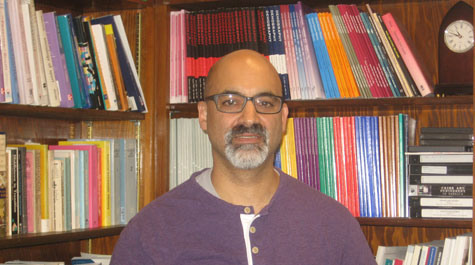Professor’s paper parses facts used to problematize immigration
Deenesh Sohoni, associate professor of sociology at William & Mary, examined demographic arguments supporting the limitation of immigration into the U.S. in a recent paper published in the journal Social Problems.
In “Restrictionist Discourse by the Numbers: The Framing of the Demographic Impacts of Immigration,” Sohoni looked at how groups seeking to restrict immigration use demographic arguments and demographic data to problematize immigration.
He points out that many of these groups use problematic numbers in an attempt to influence public policy, numbers that seemingly reflect official government sources and numbers.
“I think it’s a much more sophisticated way of creating alternative facts,” Sohoni said.
He searched the internet to compile a list of groups that support restricting immigration, aiming to analyze those operating at the national level, and supplemented it with groups from a list in the databases of watchdog groups that track them. Then he looked at the websites of each group and at the connections they had to other similar groups.
After limiting the data set to groups that had posted information in the past six months to make sure they were active, he had 42 groups. To get a snapshot to form the basis of the analysis, the websites of each group were downloaded over the course of a week.
Groups were divided up by their self-defined agendas, for example whether they were focused on immigration as a problem because of crime, environmental issues or competition with domestic labor.
{{youtube:medium:right|tq-kyMoPuJg, Examining demographic arguments about immigration}}
In trying to appear more mainstream as opposed to racist or nativist, groups present immigration as problematic for demographic reasons as one of their strategies, Sohoni said. Thirty-nine of the 42 groups used demographic arguments or demographic data to present immigration as problematic.
Sohoni was interested in why groups were using demographic arguments as well as the quality of their data.
“And so what I wanted to look at was how they used these official numbers to construct immigration as problematic and how these numbers might be biased to present immigration as a greater threat,” he said.
“Immigration is a very complicated issue. But I think that in part a lot of people are presenting or trying to get support for their positions by creating immigration as a more fearful issue. And in that way, I think the demographic numbers that make immigration seem larger or more problematic is one of their aims.”
Also the demographic arguments don’t act in isolation, but are tied to other discourses related to immigration, he said.
Sohoni noticed three dominant demographic types of arguments presented — that immigration is causing the U.S. population to grow in unsustainable ways, that many of the immigrants coming into the U.S. are illegal and that the racial composition of new immigrants is changing the composition of the U.S. in ways that are going to cause tension.
The three demographic arguments rely on official data but use it in ways that Sohoni presents as problematic and to support what he calls the “demographic threat narrative.”
For example, many groups point to the U.S. population growing to half a billion people by 2050 and 1 billion by 2100. Tracing that back to its origins, Sohoni found it is based on U.S. Census data but is the highest projection and one clearly labeled by the Census Bureau as an unlikely scenario.
Also, U.S. Homeland Security and others who study the population of illegal immigrants estimate the number to be between 9 and 13 million. Restrictionist groups say the range is between 10 million and 40 million, which Sohoni found is based on the doubling of an estimate of 20 million “based on very problematic assumptions” used in a Bear Stearns report and a Time magazine article.
“They make legitimate numbers look problematic and make problematic numbers look legitimate,” Sohoni said.
His final example is the idea that the U.S. is becoming a majority-minority population, with groups citing census data supporting that white people will become a minority by 2050. Sohoni points out that the census department actually says that white non-Hispanic people are going to become the minority population.
Choosing to describe the minority group as only white does two things, he says. It excludes Hispanics, the majority of whom are white, by assuming that regardless of how many generations they have lived in the U.S., that they truly can’t be “white.” And secondly, it excludes U.S. born African-Americans and Asians within the count as being among the native-born population threatened by immigrants.
The skewed claims gain traction by groups linking to one another’s websites, repeating numbers while citing one another as sources, and mixing official and unofficial statistics together while citing an official source that only part of the information came from, Sohoni said.
“We need to have informed debate about immigration,” he said. “What I’m saying is that we really need to understand the importance of numbers in these types of arguments and be careful about whether numbers that seem to be based on official documents and so forth are actually accurate.”
















